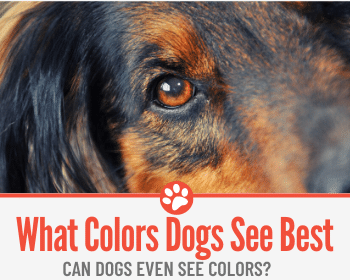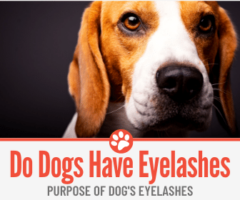 We might wonder if dogs see the world exactly as we do. We must have noticed that dogs can see well in difficult conditions and that they are attracted to fast movement.
We might wonder if dogs see the world exactly as we do. We must have noticed that dogs can see well in difficult conditions and that they are attracted to fast movement.
Then there are more difficult questions like how dogs distinguish between colors. The good news is that researchers have found answers to this question.
In This article we will see which colors can dogs see the best.
What colors do dogs see best?
It turns out that dogs can see colors. They cannot see all the colors we can, however. The easiest colors for dogs to distinguish and see are yellow and blue. Meanwhile, they struggle to identify shades of red, green and purple. Let’s explore in more details how dogs recognize these colors.
Can dogs see the color red?
No, dogs do not appear to perceive red as a distinct color. It shows up to them as a murky blend of yellow and gray. The clearest reds are mixed with less purple or orange.
These appear as yellowish with a gray or brown hue. Orange varieties look more yellow.
Can dogs see green?
Just like red, dogs do not distinguish green as a unique color. Dogs appear to perceive red and green as one similar shade of muddy yellow. This may be surprising as green is a secondary color composed of blue and yellow.
Dogs can see both primary colors. It might seem logical that they can see the combination of green. In fact, seeing the color green requires unique cells in the retina. We will read more about them below. Green colors made up of more blue are seen as a very pale gray.
Can dogs see yellow?
Yes, yellow is one of the two colors that dogs can distinguish clearly. When we see a clear, bright yellow, it will appear in the same way to dogs. Yellow can be impacted by other colors to make different blends and shades.
A dog will interpret this as yellow with various tones of gray.
Can dogs see blue?
Yes, blue is the other color that dogs can see very well, besides yellow. We remember that yellow becomes murkier in different variations. On the other hand, dogs appear to see blue more consistently.
We see many different shades of blue, such as navy and sky blue. It appears that dogs perceive these variations as being the same strong shade. Violet, as a secondary color mixed from blue and red, looks gray or a murky, gray tinged blue.
Can dogs see orange?
No, dogs apparently cannot distinguish orange. Orange is a mixture of yellow and red, so dogs will pick up the yellow component. Because they cannot see red, orange appears yellow. Oranges containing more red will be interpreted as more gray.
Can dogs see pink?
If we have ever mixed paint to create the color pink, we will know that it is basically a combination of red and white. Remember that red is perceived by dogs in various shades of gray or brown.
Dogs see pink as a lighter version of the same brown or gray tones. Different pink hues appear somewhere between light gray and an extremely pale beige.
Can dogs see purple?
Dogs apparently cannot distinguish the color purple due to its red component that they perceive as gray. Since purple generally describes various combinations of red and purple, dogs may see anything from gray tones to or a deeper or murkier blue.
Are dogs attracted to certain colors?
We have learned that most of the colors we can see appear dull and unvaried to dogs. For this reason, they will not be drawn to every color in the spectrum that we can see.
So, what’s a dog’s favorite color? As we read before, the most visible colors to dogs are yellow and blue. It might be a stretch to suggest that dogs have preferred color schemes based on the aesthetic reasons.
The question is really about which colors catch their eye and allow them to interact in the desired way. For example, if considering which color ball is the best for dogs, we need to think about how the color of the ball will affect their ability to play.
It is a good idea to avoid colors like red that they cannot see clearly. However, if we want to delve further, there are other ways to choose the color strategically. We may even consider colors that dogs cannot see.
If dogs see violet as a deeper blue, then a violet ball will stand out from the yellowish-gray tinge of a green lawn.
What color do dogs hate?
There are no colors that particularly repel dogs. The only reason for them to react badly might be if a dog had a negative experience with a given color … that is, if it is a color the dog can even identify. As we will see later, vision is not the dog’s keenest sense. So, colors are not a reliable means of communicating to dogs if you are trying to keep canines away.
Why do dogs see colors differently than we do?
The ability to see colors is based on cells called cones. Cones, and other important cells called rods, are found the retina of the eye. Cones catch light reflected off objects. This allows us to interpret colors.
Different types of cones pick up certain wavelengths of light. This means that the range of cones in the eye determines which colors can be seen. Humans generally have three kinds of cones. They pick up red, green, and blue, and various combinations. We might think that we see the complete color spectrum. In fact, it seems that there may be still more varieties of color that we cannot perceive, as suggested in this fascinating article.
Let’s not forget that humans also sometimes have different forms of color blindness. This occurs when the eyes are naturally missing one of the types of the cones. This means that certain colors are difficult to distinguish.
People with red-green color blindness struggle to identify these colors or blends including the same colors. There is also blue-yellow color blindness, named after the inability to identify those types of colors.
Dogs see more limited colors because their eyes naturally have only two kinds of cones. This condition is called having dichromatic vision. Dogs naturally see like a person with red-green color blindness.
How do we know what colors dogs can and can’t see?
Knowing exactly how things appear to others is a challenging question, especially as dogs can’t talk. What makes us believe we know what dogs can see? Scientists have tackled this challenging question in the way they always do. T
hey have carried out an investigation and careful experiments. Firstly, scientists can definitively say that dogs have fewer cones than humans.
This already indicates limitations on perceiving color.
Furthermore, experiments have been done to understand how dogs differentiate color. Jay Neitz is a color vision researcher currently based at the University of Washington.
While working at the University of California, he recently conducted experiments to understand how dogs see color. He showed them colors side by side and rewarded the dogs for identifying each one in its turn.
From the results, Neitz and the researchers agreed on the blue and yellow color spectrum that is described above. While these experiments were carried out with a scientific method, and were then carefully analyzed, we cannot be entirely sure exactly how dogs perceive the colors we see.
We can only draw conclusions about what seems to be the case.
Who sees better? Humans or dogs?
We now agree that a dog’s view of the world has less color than ours, and not very nice colors either. Can we say that dogs have inferior vision to humans?
While it’s true that sight is not a dog’s most important sense, dogs and humans each have particular advantages in their ability to interpret the world through sight.
Rods and cones
Yes, human eyes have more cones, allowing us to perceive a greater variety of colors. However, dogs have vastly more rods. As we saw earlier, rods and cones are both found in the retina. Rods are responsible for sensitivity to movement, shapes and low light.
This means that dogs are significantly better than us at picking out shapes in dim light. They are also specially attuned to rapid movements in their line of sight.
This shows that dogs and humans really do have a different picture of what is happening around them, and they focus more on what is important to them.
It’s just a case of priorities, really. Until dogs start taking more interest in art and floral arrangements–and I don’t mean as a snack–they don’t really need to see these colors anyway.
Eye placement
One important factor in how we see is based on where our eyes sit in our heads. Human eyes are front-facing and close together, which helps our eyes work as a team.
Our brains create images from what both eyes see while working together on two sides.
This forms a complete picture of distance and dimensionality, using depth perception, which is important for the ability to focus and make accurate movements within our space. Dogs’ eyes are more widely set and sit closer to the sides of their heads than the front.
This means they have more limitations on their depth perception. While it might be harder for dogs to play baseball, they do still have some degree of depth perception.
One great advantage that dog enjoy with their eye placement is their much wider scope of peripheral vision. Human sight is focused at the front. We can see forward and a little to the sides.
However, we are not able to see as extensively as dogs can on either side of their heads. On the other hand, dogs may see in a wider arc. They are also generally more short-sighted than the average human. The good news for dogs is that they don’t rely as heavily on vision as we do.
Why dogs don’t need to see colors like we do
Dogs are not as reliant on sight as we are because their other senses are significantly more advanced than ours.
Smell
A dog’s sense of smell is estimated to be over 10,000 times stronger than that of humans. It may reach as much as 100,000 times greater than ours.
Dogs may struggle to identify something by sight because of its color or distance from them. However, their ability to find it using smell will certainly make up for it. Dogs are able to process smells that we would not even know existed based on our own senses.
This is why dogs are used for their incredible ability in tasks such as tracking and identifying dangerous substances. Dogs have also been investigated for their potential in detecting cancer, with some promising results.
Hearing
This is the second most important sense for dogs after smell. Dogs can pick up sounds that are much quieter and at a higher frequency than we can.
Their excellent hearing is aided by the size of their ears and the ability to move their ears in the direction of the noise.
Touch
Dogs even have advantages in their sense of touch. While much of their perception is generated through their skin, which is why they love being petted, they also have amazing sensitivity in their whiskers.
Through these fine hairs, they can feel small vibrations and changes in air currents. This sensitivity does not really replace their poor eyesight since it is focused on what the eye cannot see. However, it is a good example of dogs’ unique sensory strengths.
Taste
This is actually the most underdeveloped of a dog’s senses. In fact, dogs have far fewer taste buds than we do, with one sixth the number that humans have. This is believed to be why dogs are so willing to eat almost anything, even if we would find the flavors very unappealing.
To sum it all up, dogs can see colors, but their view of the world is not as bright, varied, or clearly defined as what we perceive. The ability to see colors is based on the existence of cells, called cones, in our eyes.
Dogs’ retinas have fewer cones than human eyes. As a result, dogs are unable to identify red or green, and cannot process certain combinations containing these colors.
They see the world in shades of blue and yellow. However, dogs do not rely on sight in the same way that we do. Most of their other senses are finely-tuned to help them succeed in the things that dogs do best.






